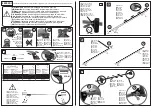
300 TROUBLESHOOTING
Troubleshooting Lighting Problems
See Chapter 5 for service procedures
Condition
Possible Cause
One or more lights don't work, but
others do
1. Defective bulb(s)
2. Blown fuse(s)
3. Dirty fuse clips or light sockets
4. Poor ground circuit
Lights burn out quickly
1. Incorrect voltage regulator setting or de
fective regulator
2. Poor battery/alternator connections
Lights go dim
1. Low/discharged battery
2. Alternator not charging
3. Corroded sockets or connections
4. Low voltage output
Lights flicker
1. Loose connection
2. Poor ground. (Run ground wire from
light housing to frame)
3. Circuit breaker operating (short circuit)
Lights "flare"—Some flare is normal
on acceleration—If excessive, see
"Lights Burn Out Quickly"
High voltage setting
Lights glare—approaching drivers
are blinded
1. Lights adjusted too high
2. Rear springs or shocks sagging
3. Rear tires soft
Troubleshooting Dash Gauge Problems
Most problems can be traced to a defective sending unit or faulty wiring. Occasionally, the
gauge itself is at fault. See Chapter 5 for service procedures.
Condition
Possible Cause
COOLANT TEMPERATURE GAUGE
Gauge reads erratically or not at all
1. Loose or dirty connections
2. Defective sending unit.
3. Defective gauge. To test a bi-metal gauge, remove the wire from
the sending unit. Ground the wire for an instant. If the gauge
registers, replace the sending unit. To test a magnetic gauge,
disconnect the wire at the sending unit. With ignition ON gauge
should register COLD. Ground the wire; gauge should register
HOT.
AMMETER GAUGE—TURN HEADLIGHTS ON (DO NOT START ENGINE).
NOTE REACTION
Ammeter shows charge
Ammeter shows discharge
Ammeter does not move
1. Connections reversed on gauge
2. Ammeter is OK
3. Loose connections or faulty wiring
4. Defective gauge
















































